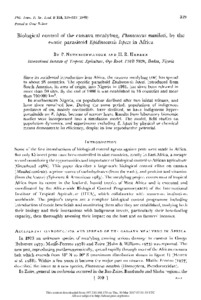| dc.contributor.author | Neuenschwander, P. |
| dc.contributor.author | Herren, H.R. |
| dc.contributor.author | Harpaz, I. |
| dc.contributor.author | Badulescu, D. |
| dc.contributor.author | Akingbohungbe, A.E. |
| dc.date.accessioned | 2019-12-04T11:08:06Z |
| dc.date.available | 2019-12-04T11:08:06Z |
| dc.date.issued | 1988-02-28 |
| dc.identifier.citation | Neuenschwander, P., Herren, H.R., Harpaz, I., Badulescu, D. & Akingbohungbe, A.E. (1988). Biological control of the cassava mealybug, Phenacoccus manihoti, by the exotic parasitoid Epidinocarsis lopezi in Africa. Philosophical Transactions of the Royal Society of London. Series B, Biological Sciences, 318(1189), 319-333. |
| dc.identifier.uri | https://hdl.handle.net/20.500.12478/1724 |
| dc.description.abstract | Since its accidental introduction into Africa, the cassava mealybug (CM) has spread to about 25 countries. The specific parasitoid Epidinocarsis lopezi, introduced from South America, its area of origin, into Nigeria in 1981, has since been released in more than 50 sites. By the end of 1986 it was established in 16 countries and more than 750 000 km<latex>$^2$</latex>. In southwestern Nigeria, CM populations declined after two initial releases, and have since remained low. During the same period, populations of indigenous predators of CM, mainly coccinellids, have declined, as have indigenous hyper-parasitoids on E. lopezi, because of scarcer hosts. Results from laboratory bionomic studies were incorporated into a simulation model. The model, field studies on population dynamics, and experiments excluding E. lopezi by physical or chemical means demonstrate its efficiency, despite its low reproductive potential. |
| dc.description.sponsorship | International Fund for Agricultural Development |
| dc.description.sponsorship | International Fund for Agricultural Research |
| dc.description.sponsorship | Government of Austria |
| dc.description.sponsorship | Food and Agriculture Organization of the United Nations |
| dc.description.sponsorship | United States Agency for International Development |
| dc.format.extent | 319-333 |
| dc.language.iso | en |
| dc.subject | Biological Control Agents |
| dc.subject | Insect Pests |
| dc.subject | Cassava |
| dc.subject | Parasitoid |
| dc.subject | Epidinocarsis Lopezi |
| dc.subject | Cassava Mealybug |
| dc.title | Biological control of the cassava mealybug, Phenacoccus manihoti, by the exotic parasitoid Epidinocarsis lopezi in Africa [and Discussion] |
| dc.type | Journal Article |
| dc.description.version | Peer Review |
| cg.contributor.affiliation | International Institute of Tropical Agriculture |
| cg.contributor.affiliation | Hebrew University of Jerusalem |
| cg.contributor.affiliation | University of Reading |
| cg.contributor.affiliation | University of Ile-Ife |
| cg.coverage.region | Africa |
| cg.coverage.region | Africa South Of Sahara |
| cg.coverage.region | West And Central Africa |
| cg.coverage.country | Angola |
| cg.coverage.country | Cameroon |
| cg.coverage.country | Congo |
| cg.coverage.country | Malawi |
| cg.coverage.country | Nigeria |
| cg.coverage.country | Rwanda |
| cg.coverage.country | Zambia |
| cg.isijournal | ISI Journal |
| cg.authorship.types | CGIAR and developing country institute |
| cg.authorship.types | CGIAR and advanced research institute |
| cg.iitasubject | Cassava |
| cg.iitasubject | Pests Of Plants |
| cg.journal | Philosophical Transactions of the Royal Society of London. Series B, Biological Sciences |
| cg.howpublished | Formally Published |
| cg.accessibilitystatus | Limited Access |
| local.dspaceid | 82995 |
| cg.targetaudience | Scientists |
| cg.identifier.doi | https://dx.doi.org/10.1098/rstb.1988.0012 |

